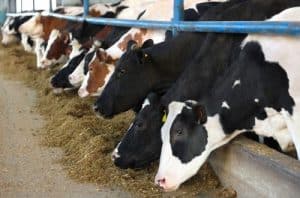Summer’s warm weather is welcomed by most people. But that’s not necessarily the case for cattle, horses and other farm animals. For these animals, summertime means sweltering barns, with little relief outdoors when shade is lacking.
Farmers know the importance of carefully monitoring their livestock’s health, especially during times of the year when heat stress commonly causes complications. However, merely watching and waiting for signs of trouble isn’t always the ideal way to handle hyperthermia, or overheating. Instead, farmers must take proactive steps to prevent overheating from occurring.
HVLS fans help keep animals comfortable
One strategy that is becoming increasingly more common on dairy farms is the use of high velocity, low speed, or HVLS, fans. These fans have blades that span anywhere from 4 to 12 feet and can move massive amounts of air. Though they move slowly, they are highly effective at cooling down an area.
But, before these giant fans can help cattle cool down, they must be installed properly and maintained regularly. It’s important that they are installed correctly and securely the first time for HVLS fans to have maximum effect. By working with the experts at Miner, farmers can feel confident that their livestock will enjoy a cooling breeze all summer long.
The dangers of overheated animals
The true benefits derived from HVLS fans can be traced back to understanding the core causes and dangers associated with heat-stressed animals.
Anyone who has been stuck in an unairconditioned room on a hot day knows the discomfort of being too hot. Animals feel the same way. But, for them, this discomfort is difficult to escape.
When animals overheat, their health often suffers. For example, a cow that’s too hot will almost always decrease, or even stop, eating. Slowing the metabolism is the cow’s way of reducing heat and energy use. But an underfed cow isn’t any better than an overheated one. And, for the dairy farmer who counts on healthy cows to produce milk as an important part of his or her income, an overheated, underfed cow can be a detriment to the farm; cows don’t produce milk as well when they’re unhealthy.
The Manitoba Co-operator , one of the oldest livestock publications, also pointed out that cattle that give birth during the summer heat are at a particular disadvantage. Calving takes plenty of energy, and an already sick mother will have a difficult time birthing. Plus, at this point, it’s not just the cow that’s in danger; it’s the calves as well.
Cows that aren’t pregnant yet, but whose owners are hoping for the addition, are also likely to be hindered by overheating. Like metabolism, fertility also takes a dip when animals are too hot.
Hyperthermic animals’ immune systems are often less effective, which means that overheated animals are more prone to infection and disease. In fact, the Manitoba Co-operator suggested that farmers ask their veterinarians about proactively prescribing antibiotics to ward off pneumonia and other common illnesses.
Experiments demonstrate effectiveness of HVLS fans
The University of California at Davis, which has a large agriculture specialty, conducted experiments with fans of various sizes and speeds to determine which was best to keep cattle cool.

Over the course of two summers, researchers turned fans on for three days at a time, then off for three days at a time. The fans used were:
- An HVLS fan with a 20-foot diameter and rotating at 50 revolutions per minute.
- A LVHS (low volume high speed) fan with a 5-foot diameter and rotating at 330 rpm.
- A 5-foot low-speed fan (which would be effective for a smaller barn without the room for a 20-foot fan).
The researchers noticed that the cows were most productive and seemed to be most content during feeding and resting times when they had the comfort of a fan – regardless of size or speed. However, the low-speed fans provided farmers with significant energy savings, as running a fan at high speeds requires enormous power demands.
Similar research conducted in Wisconsin, in conjunction with Wisconsin Public Service, found that several dairy farmers reported a noticeable difference in the air quality of their barns after the fans were installed. Increased air circulation can help remove dust and debris, as well as smells and standing heat. A few farmers also noted fewer flies in their barns after installing the fans – something the cows may be grateful for.
Further, and perhaps more importantly for the dairy farmer, was the increased production of milk on hot days after the fans were installed. Though the researchers didn’t measure milk production, the farmers were confident that production was better on particularly warm days after the fans were installed than it was prior to the upgrade. Additionally, even when milk production decreased, the cows seemed to rebound more quickly after the fans were installed.
To learn more about HVLS fan installation in your barn, or to get an expert up in your rafters to make sure your current fans are in good condition, reach out to Miner, Corp.
